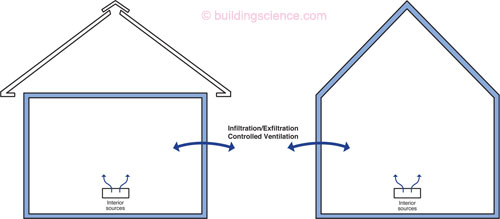“What we’ve got here is failure to communicate . . .”1
In what is turning out to be an unfortunate turn of phrase the terms “unvented attics” and “unvented roofs” have entered the lexicon. A lot of the blame for that goes to me and for that I am sorry. The “right” terms should have been “conditioned attics” and “conditioned roofs”2.
When we move insulation to the underside of a roof deck3 the space below the insulation is now within the “conditioned space”. This has all kinds of implications…some good…some not so good.
Note that "within the conditioned space" also means within the air control layer of the conditioned space. An "unvented roof" or "unvented attic" needs to be "airtight" relative to the exterior. Did I mention "airtight"?
The good implications are that if we locate ductwork and air handlers and sprinklers in the attic space we don’t have to worry about the thermal penalties associated with duct leakage and the moisture penalties associated with induced negative pressures and the durability issues associated with locating equipment in hostile environments and the freezing pipe issues associated with sprinkler systems.
The bad implications are that we can accumulate moisture in the attic and attic assemblies if we don’t have a means of removing the moisture.
In what has become an amazing turn of events folks are figuring out how to construct tight ducts—even when they are located “inside”. Mastic rules (Photograph 1). All of this is good. The only place air should exit a duct or enter a duct is at a grille or register. So what is the problem?
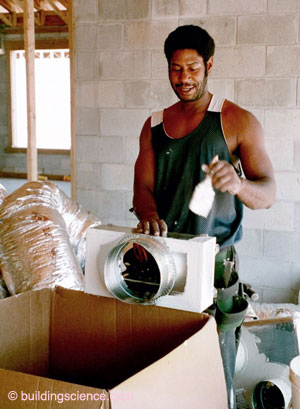
Photograph 1—Mastic Rules: I did not think I would live to see the day where mastic is used to seal all ductwork not just ductwork outside the conditioned space. Woo-hoo!
Well, when we located leaky ducts in “unvented attics” the leaky ducts provided “conditioning” to the attic space. Leaky supply ducts supplied conditioned air into the attic space. This air would find its way back into the main part of the building - the space below the ceiling gypsum board - since the ceiling gypsum board was typically also leaky and presto we had air change between the attic space and the main part of the building. This air change coupled the attic space to the rest of the building (Figure 1). We had “communication” between the attic and the rest of the building. Cool Hand Luke would have been proud.
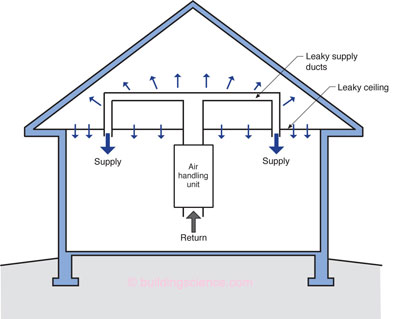
Figure 1—Leaky Supply Ducts In Unvented Attics: When we located leaky ducts in “unvented attics” the leaky ducts provided “conditioning” to the attic space. Leaky supply ducts supplied conditioned air into the attic space. This air would find its way back into the main part of the building—the space below the ceiling gypsum board - since the ceiling gypsum board was typically also leaky and we had air change between the attic space and the main part of the building. This air change coupled the attic space to the rest of the building. We had “communication” between the attic and the rest of the building. Cool Hand Luke would have been proud.
Figure 2a (above left) and Figure 2b (above right)—Where Did the Moisture Come From? Mostly from inside and from air change. Let’s assume that interior moisture generation is the same for both of these figures. So far so good. Here is where the complications begin when folks try to do analysis and modeling. Unvented attics typically lead to significantly tighter building enclosures compared to building enclosures with vented attics. The differences are often more than 50 percent. That leads to a huge reduction in infiltration and exfiltration. Note I did not use the word air change in the figures—I used infiltration/exfiltration and controlled ventilation. If air changes are set to be equal in both cases the moisture gain via air change in the building with the unvented attic would be greater than the building with the vented attic as its volume is greater. But they are not equal in the real world. Folks who try to model this sometimes forget. The problem with the unvented attic is that mixing is necessary to get the moisture from infiltration/exfiltration and controlled ventilation to the air conditioner so that it can remove this moisture by dehumidification. This is not an energy penalty compared to the building with the vented attic—the interior moisture originating via infiltration/exfiltration and controlled ventilation in the building with the vented attic still has to be removed by the air conditioner. In the real world the amount of moisture having to be removed by the air conditioner is typically less for the building with the unvented attic because the infiltration/exfiltration and controlled ventilation is less because the building enclosure is tighter. But this moisture removal only occurs if there is communication or mixing of the entire enclosure. There is no “energy penalty” for removing moisture from “conditioned attics”. It gets more strange in the modeling world. According to some folks in buildings with vented attics the moisture from the attic is removed “passively” by attic ventilation. This moisture is assumed to come from the house and therefore there apparently is an energy advantage from constructing a leaky ceiling and venting house moisture through this leaky ceiling resulting in “free” dehumidification. Really? The air that leaves through the attic ceiling has to be replaced with air from the outside. Seems to me that there appears to be a misunderstanding on how to draw the free body diagram around the system.
What was significant about the communication? The air change provided a means of removing moisture that found its way into the attic space. Where did the moisture come from? Mostly from inside and from air change (Figure 2a and Figure 2b). It did not come through the roof shingles—despite what I thought a decade ago (Photograph 2, Photograph 3 and Photograph 4).
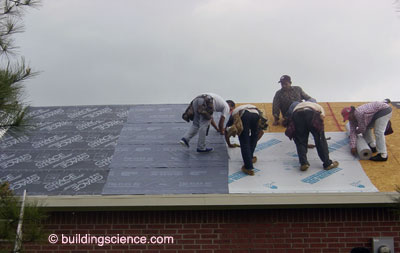
Photograph 2—Test Attic in Houston: To this day I am amazed at what builders are willing to do to figure stuff out. David Weekley Homes said “sure” we will let you have one of our garage attics for a year on one of our sales models if you figure out if stuff from outside is being driven inside. Hat tip to Mr. Weekley. I was worried that moisture from dew and rain would wick into the overlaps of asphalt shingles and be driven inwards by solar radiation and lead to increased moisture contents in roof sheathing—especially in unvented roof assemblies—turned out I was wrong.
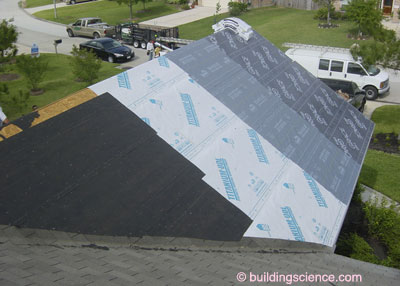
Photograph 3—Permeable and Impermeable Roofing Underlayments: Turned out that there was no measurable effect of roofing underlayment permeability on inward moisture drive through the roofing assembly.
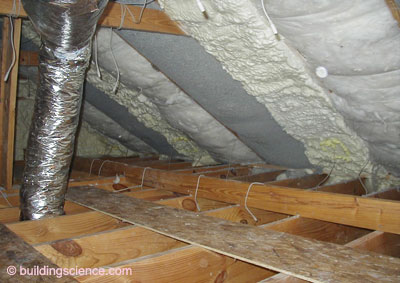
Photograph 4—Roof Deck Insulation Type: We looked at all of them. They responded differently to interior moisture but did not respond differently to exterior moisture. There was no measurable exterior moisture effect.
How come the moisture ends up in the attic space and not in the main part of the building? Ah, Grasshopper, moisture laden air is lighter and less dense than dry air. Moisture laden air ends up in the attic due to this “hygric buoyancy”. Check out Table 1. The molecular weight of dry air is 29. The molecular weight of water vapor is 18. Mixing dry air with a molecular weight of 29 with water vapor with a molecular weight of 18 reduces the molecular weight of the mixture and therefore the density. In language that will irritate a physicist the “moisture laden air floats up to the top of the attic”. If we don’t do something about this—the moisture will hang out and cause trouble especially if we have low-density open-cell spray polyurethane (SPF) as our insulation system.
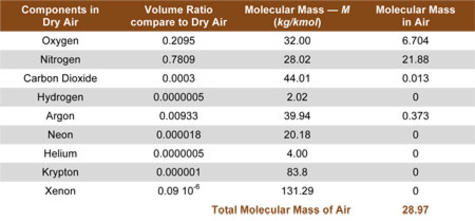
Table 1: Molecular Mass of Air—The terms “molecular mass and molecular weight” are interchangeable; table data courtesy of The Engineering ToolBox
Why do we have to worry about low-density open-cell SPF? It is very vapor open—around 30 perms per inch of thickness—and will allow moisture to pass through it and migrate to the underside of the roof deck (Photograph 5). This is not typically a problem as solar radiation drives this moisture back down out of the foam and back into the attic space air where it is usually removed by air change created by leaky ducts.
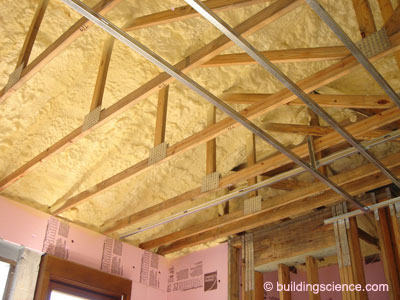
Photograph 5—Low-Density Open-Cell Spray Polyurethane Foam: It is very vapor open—around 30 perms per inch of thickness—and will allow moisture from the interior to pass through it and migrate to the underside of the roof deck. This is not typically a problem as solar radiation drives this moisture back down out of the foam and back into the attic space air where it is usually removed by air change created by leaky ducts.
Recall that ventilation in the winter removes interior moisture and air conditioning or dehumidification removes interior moisture in the summer. We know how to do this—even in ultra efficient low load buildings. We just forgot that these attics were part of the space that needed to have this done. The leaky ductwork and leaky ceilings made it happen—until it stopped happening when ducts got tighter and ceilings got tighter.
So why not just use high-density closed-cell foam or apply a vapor retarder? Well, there are all sorts of other desirable properties associated with low-density open-cell SPF such as its fire performance and its “drying” properties and its “green” properties if “green” is your thing. For some folks blowing agents matter especially if they are “green”. And, I am not entirely convinced that in some climates that even high-density closed-cell foam with be without issues if there is no “communication”.
The solution is pretty easy—just add a supply and return to the attic space and be done with it. So how much air do you need to supply and return? Ah, that part is pretty easy—50 cfm for every 1,000 ft2 or ceiling area. Where does this number come from? It is around 1/3 to 1/2 air changes per hour (ach) and it corresponds to our experience from the measurement of leaky ductwork using tracer gas back in the day (check out the references at the end of this column). It is also the same number we find in the model codes to condition “unvented crawl spaces” and crawl spaces are a lot more problematic that attic spaces—so we are starting with a very conservative flow rate.
But now we get into a real can of worms. Huh? The most common way of constructing a conditioned attic is to spray low-density or high-density polyurethane foam to the underside of the roof deck. These foams burn. They require the application of an intumescent coating. OK, everyone knows that. We are already applying the intumescent coating so what is the problem? Yes, that is true, but the assumption behind the approval of the use of intumescent coatings is that air from the attic does not communicate with the rest of the building. It was (and is) a dumb assumption.
Recall that the whole point of the exercise originally was to deal with the issue of leaky ducts. That’s why we moved the insulation to the roof deck so that the ducts were “inside” and then it didn’t matter if they were leaky. The fire folks more or less played along. The ducts were leaky, the air handlers were leaky, the ceiling was leaky and there was incidental air change between the attic space and the rest of the building. How much air change? It varied all over the place. I already mentioned that we did some tracer gas measurements back in the day and somewhere between 1/3 to 1/2 of an ach was fairly typical.
Did I mention that this “air change reality” was ignored more or less “by the authorities having jurisdiction”? Why? Well, these attics were a whole lot better than vented attics with leaky ducts and leaky ceilings from both an energy perspective and a fire perspective. So folks held their tongues.
But this all changes when I add a supply and return duct coupled to an air handler. Folks heads explode. Apparently “incidental” air change is ok—but “real” air change is not—even if the “real” air change is in the same quantities of the “incidental” air change. Welcome to the “code world”. None of the International Code Council Evaluation Service (ICC-ES) Evaluation Reports for spray foam insulations allow this type of application if there is “real” air change or communication with the “occupied space”. Unless, the spray foam is covered with gypsum board. Cover the spray foam with gypsum board? Not going to happen. So now what?
There is an option. We can install a smoke detector in the return duct that is coupled to air handler and a fire alarm so that in the event of a fire the system is shut down. We do this commercially, we need to do this residentially. And we need to codify this in the Model Codes.
Now we have a problem. We are on a three-year code cycle—and I missed this round. The best way to handle it in the short term is to go to your Chief Building Official and tell him/her that you are going to add a supply and return with the smoke sensor alarm set up and plead for approval. The Chief Building Official has the authority to accept this. Be nice. And expect this to take time. Check out the Side Bar (below)—the sections extracted from the International Mechanical Code might be helpful to you in your discussions with the Chief Building Official if you take this route.
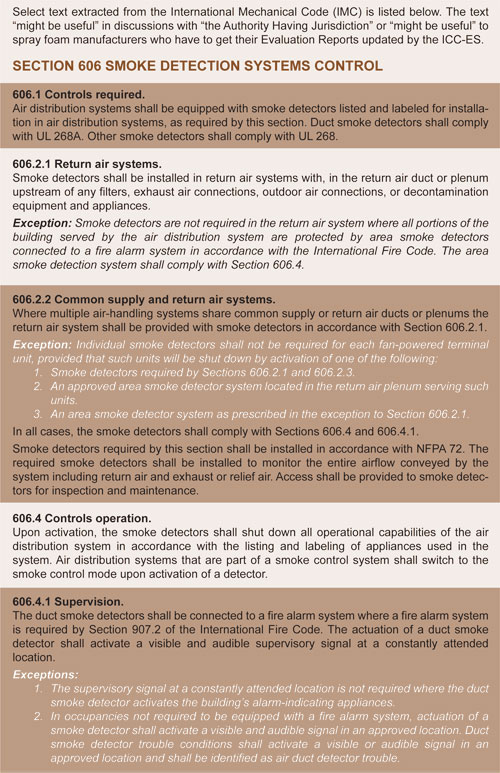
The mid-term way to handle this is to have the spray foam manufacturers go to the ICC-ES and get their Evaluation Reports changed.
The long-term way to handle this is to change the Model Codes. I am on that one, but we are looking at 2018 at the earliest.
Of course we could just go back and construct leaky ducts and leaky ceilings…I am kidding. I am kidding. Or am I?
"Are we done yet?" Nope. When we construct a conditioned attic or conditioned roof we save a significant amount of energy. This is good...right? Ah, the thermal load is less...often way less...and the air conditioner does not run as much. This is good...right? Ah, when the air conditioner is not running it is not dehumidifying. We can end up with a "part load humidity" problem. Most conditioned attics...conditioned roof buildings...and energy efficient buildings in general located in hot-humid and mixed-humid climates need supplemental dehumidification...from...wait for it...a dehumidifier. Yup, a dehumidifier. Remember the movie "The Graduate" when Dustin Hoffman says "the future is plastics"...he should have said "the future is dehumidifiers..."
References
Lstiburek, J.W.; Unvented Attic Performance, ASHRAE/BETEC, Thermal Performance of Buildings VII, Clearwater Beach, Florida, December 1998.
Rudd, A.F. and Lstiburek, J.W.; Vented and Sealed Attics in Hot Climates, ASHRAE Transactions, June 1998.
Rudd, A.F., J.W. Lstiburek, and N.A. Moyer; “Measurement of Attic Temperatures and Cooling Energy Use In Vented and Sealed Attics in Las Vegas, Nevada”, EEBA Conference, Minneapolis, MN, March 1997.
Footnotes
- This classic line comes from the 1967 movie Cool Hand Luke. Paul Newman starred in the lead role and was nominated for the Academy Award for Best Actor. George Kennedy won the Academy Award for Best Supporting Actor in the same film. In the films most memorable scene Luke wins a poker game by bluffing. George Kennedy playing the character Dragline exclaims: “Nothin’. A handful of nothin’. You stupid mullet head. He beat you with nothin’. Just like today when he kept comin’ back at me—with nothin’.“ Paul Newman playing Luke responds: “Yeah, well sometimes nothin’ can be a real cool hand.” Dragline then nicknames him “Cool Hand Luke” and a legendary movie character is born.
- Exactly the same terminology issues exist with “unvented crawlspaces” which should have been referred to as “conditioned crawlspaces”…but we will leave that for another time.
- Or directly on top of a roof deck…

